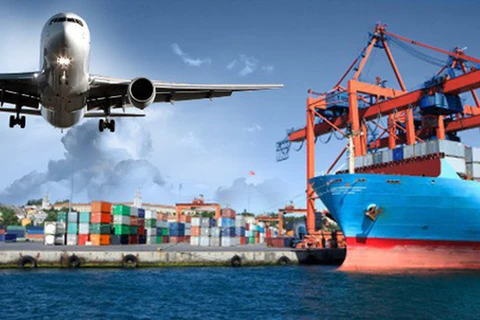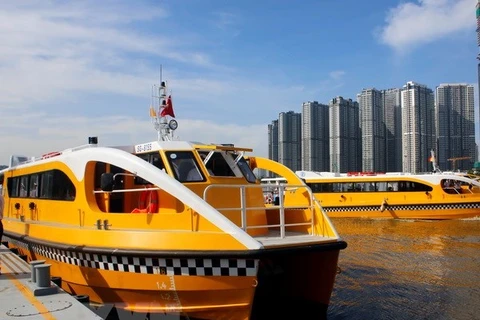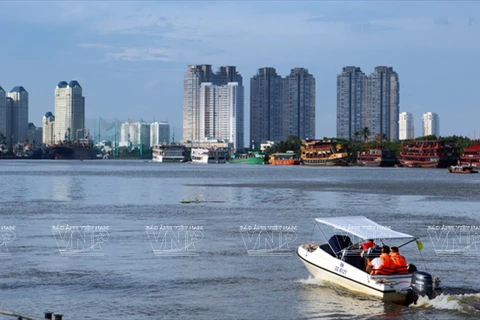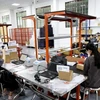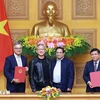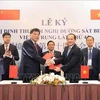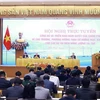Hanoi (VNS/VNA) - A lack of investment in inland waterways has stunted the development of water-borne shipping and made Vietnam’s logistics sector heavily dependent on more expensive road transport.
With up to 2,360 rivers stretching a total of 42,000 kilometres, Vietnam boasts huge potential for a strong water-based transport system.
The newly opened river to sea transport routes are the realisation of some of this long-neglected potential, said Tran Bao Ngoc, Director of the Transportation Department under the Ministry of Transport.
After three years of operation starting in July 2014, vessels running on those routes managed to deliver 47 million tonnes of cargo – far exceeding the Government’s target of 17.1 million tonnes in 2020 and 30.3 million tonnes in 2030.
That achievement, however, was dwarfed by the colossal amount of goods transported on Vietnam’s roads. A report by the General Statistics Office of Vietnam showed that freight road transport reached 405.3 million tonnes in the first seven months of this year despite the average cost for delivering a container via the roadways being five to seven times higher than that of water-based shipping.
Poor waterway infrastructure was the fatal weakness of the sector.
“Most of the vessels are old and outdated, infrastructure investment and maintenance are neglected and the connection between the road, rail and sea transport sectors is yet to be planned properly to create a thorough logistics network,” said Inland Waterways Administration General Director Hoang Hong Giang.
“All of this makes it impossible to call for more investment into the sector.”
Le Anh Son is Chairman of the board of the Vietnam National Shipping Lines (Vinalines), one the country’s leading corporations in sea ports and maritime transport. He argued that any inland river routes must have proper planning and qualified ports.
“But planning always lags behind market demand,” he said.
A Government blueprint on restructuring the transport sector during the period from 2016 to 2020 aims to cut the volume of cargo transported on roads down to 54.4 percent from the current rate of more than 70 percent. The percentage of cargo transported on inland waterways, on the other hand, will nearly double from 18 percent to around 32.4 percent.
The attempt to reduce the dependence on road transport would require a huge investment into inland waterways. However, the Government still spent more than 70 percent of its total budget for transport infrastructure on roads, 15 percent for railways, 7.6 percent for aviation and just 4.6 percent on maritime projects. Inland waterways received the smallest amount of funding – around just two percent.
Vice Chairman of the National Assembly’s Ombudsman Committee Luu Binh Nhuong said this level of investment in inland waterways was “barely enough for the sector to survive,” let alone enough for it to develop and modernise.
“The Ministry of Transport should be the one to assess the market demand for water-borne transport and help the Government and localities work out solutions for various problems,” he said. “Where should we call for private investment? Do we need to offer any kind of subsidy? What investment model should we encourage? Can we accept foreign investment?”
National Assembly deputy Pham Van Hoa urged the Government to create a legal framework and policies for investors in order to attract more capital into the underdeveloped sector.
Le Anh Son, meanwhile, said the Government did not necessarily need to spend the State budget to develop inland waterways. It could apply the Build-Operate-Transfer (BOT) model that was very popular in road investment over the last few years to mobilise money from private investors.-VNS/VNA
With up to 2,360 rivers stretching a total of 42,000 kilometres, Vietnam boasts huge potential for a strong water-based transport system.
The newly opened river to sea transport routes are the realisation of some of this long-neglected potential, said Tran Bao Ngoc, Director of the Transportation Department under the Ministry of Transport.
After three years of operation starting in July 2014, vessels running on those routes managed to deliver 47 million tonnes of cargo – far exceeding the Government’s target of 17.1 million tonnes in 2020 and 30.3 million tonnes in 2030.
That achievement, however, was dwarfed by the colossal amount of goods transported on Vietnam’s roads. A report by the General Statistics Office of Vietnam showed that freight road transport reached 405.3 million tonnes in the first seven months of this year despite the average cost for delivering a container via the roadways being five to seven times higher than that of water-based shipping.
Poor waterway infrastructure was the fatal weakness of the sector.
“Most of the vessels are old and outdated, infrastructure investment and maintenance are neglected and the connection between the road, rail and sea transport sectors is yet to be planned properly to create a thorough logistics network,” said Inland Waterways Administration General Director Hoang Hong Giang.
“All of this makes it impossible to call for more investment into the sector.”
Le Anh Son is Chairman of the board of the Vietnam National Shipping Lines (Vinalines), one the country’s leading corporations in sea ports and maritime transport. He argued that any inland river routes must have proper planning and qualified ports.
“But planning always lags behind market demand,” he said.
A Government blueprint on restructuring the transport sector during the period from 2016 to 2020 aims to cut the volume of cargo transported on roads down to 54.4 percent from the current rate of more than 70 percent. The percentage of cargo transported on inland waterways, on the other hand, will nearly double from 18 percent to around 32.4 percent.
The attempt to reduce the dependence on road transport would require a huge investment into inland waterways. However, the Government still spent more than 70 percent of its total budget for transport infrastructure on roads, 15 percent for railways, 7.6 percent for aviation and just 4.6 percent on maritime projects. Inland waterways received the smallest amount of funding – around just two percent.
Vice Chairman of the National Assembly’s Ombudsman Committee Luu Binh Nhuong said this level of investment in inland waterways was “barely enough for the sector to survive,” let alone enough for it to develop and modernise.
“The Ministry of Transport should be the one to assess the market demand for water-borne transport and help the Government and localities work out solutions for various problems,” he said. “Where should we call for private investment? Do we need to offer any kind of subsidy? What investment model should we encourage? Can we accept foreign investment?”
National Assembly deputy Pham Van Hoa urged the Government to create a legal framework and policies for investors in order to attract more capital into the underdeveloped sector.
Le Anh Son, meanwhile, said the Government did not necessarily need to spend the State budget to develop inland waterways. It could apply the Build-Operate-Transfer (BOT) model that was very popular in road investment over the last few years to mobilise money from private investors.-VNS/VNA
VNA

